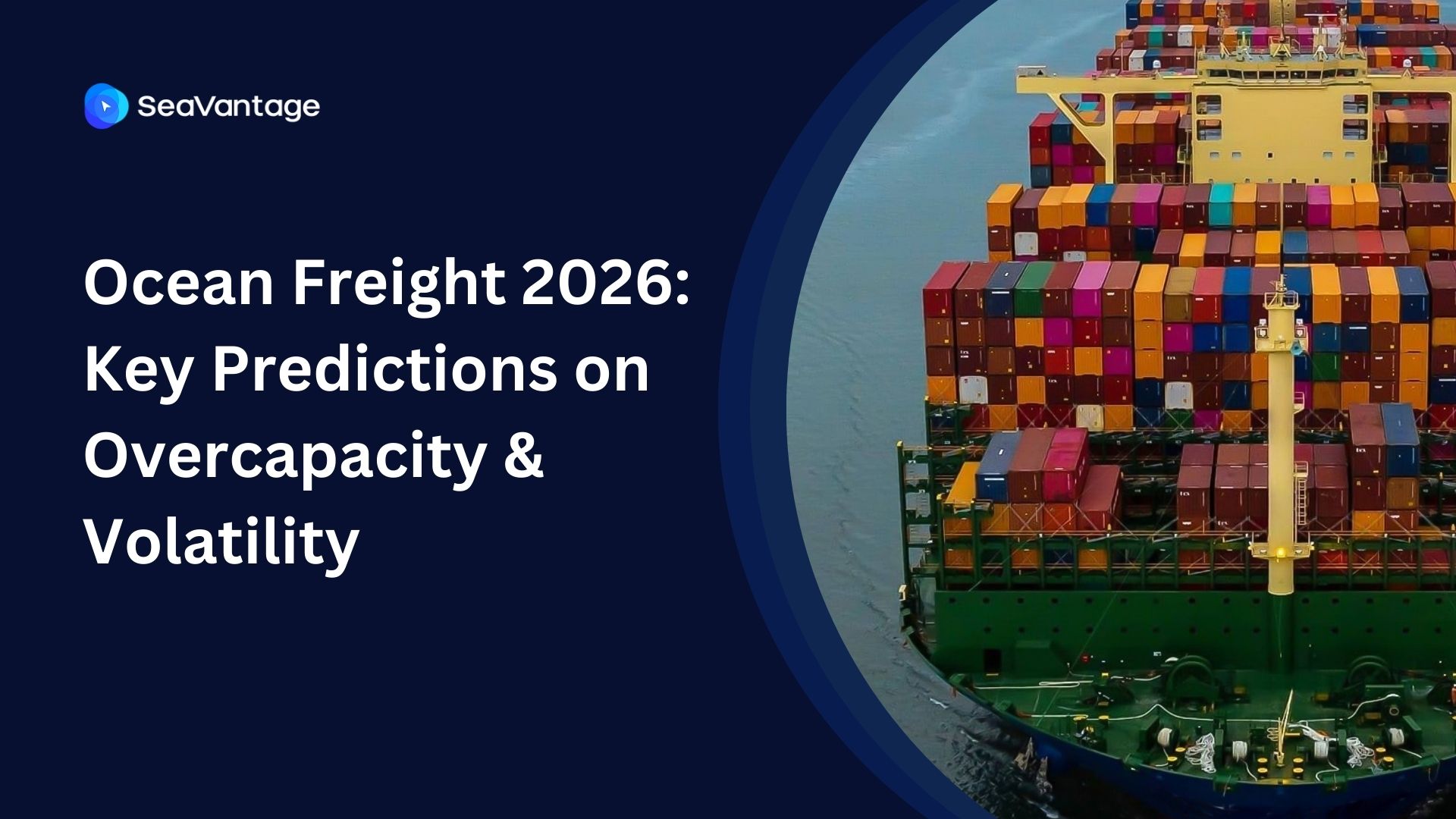The 2025 Guide to Ocean Freight Tracking: Tools, Trends & Best Practices

The Growing Importance of Ocean Freight Tracking
In an era where speed, accuracy, and transparency define supply chain success, ocean freight tracking is no longer optional—it's essential. As global trade intensifies and customer expectations evolve, companies are under pressure to provide real-time, predictive insights into the status of their shipments.
According to the Bureau of Transportation Statistics, freight transportation remains a critical enabler of global commerce, and ocean shipping accounts for more than 80% of world trade by volume. With challenges like port congestion, labor shortages, and unpredictable weather events, businesses are increasingly turning to advanced tracking systems to mitigate risks and deliver consistent performance.
In this guide, we’ll explore the evolving landscape of ocean freight tracking in 2025—highlighting tools, trends, and best practices for a more resilient, transparent, and efficient supply chain.
Read more on supply chain visibility →
Understanding Ocean Freight Tracking
Ocean freight tracking is the process of monitoring the movement, condition, and location of sea freight—typically containerized cargo—throughout its journey from origin to destination. It encompasses several components:
- Container tracking: Uses GPS and AIS (Automatic Identification Systems) to monitor container locations.
- Bill of Lading (BoL) tracking: Follows legal documents that detail the shipment’s contents and ownership.
- Cargo vessel tracking: Provides real-time insights into the ship’s position, ETA, and route status.
Depending on your supply chain strategy, you may rely more heavily on a container number or a master bill of lading for tracking. Understanding the difference is crucial for operational precision. Here’s a helpful breakdown →
Benefits of Ocean Freight Tracking
- Improved ETA accuracy and on-time delivery
- Early alerts for disruptions and delays
- Enhanced customer service and communication
- Streamlined customs and regulatory compliance
- Reduced detention, demurrage, and storage fees
Key Challenges in Ocean Freight Tracking
Despite its many benefits, ocean freight tracking is far from perfect. In 2025, logistics professionals continue to face several obstacles:
1. Data Fragmentation
Shipping data often exists in silos—across carriers, freight forwarders, and port authorities. This fragmentation makes it difficult to maintain a unified view of cargo movement.
2. Inconsistent Real-Time Updates
Although many carriers offer tracking portals, data updates can be delayed or missing, especially when vessels are in remote waters or outside satellite range.
3. Lack of Standardization
With no universal format for transmitting tracking information, integration between systems can be cumbersome and error-prone.
4. Regulatory Complexity
Cross-border shipments are subject to a patchwork of regulations, customs requirements, and documentation standards, all of which can disrupt seamless tracking.
By addressing these gaps, businesses can unlock more reliable and scalable tracking capabilities that support global logistics performance.
Technological Advancements Enhancing Tracking Capabilities
Thanks to rapid digital innovation, tracking systems in 2025 are far more sophisticated than even five years ago. Here's how technology is transforming visibility:
IoT Devices and Smart Containers
Internet of Things (IoT) sensors embedded in containers can transmit real-time data on temperature, humidity, shock, tilt, and location. This is particularly useful for sensitive cargo like pharmaceuticals or perishables.
Predictive Analytics and AI
AI-powered platforms analyze vast amounts of shipment data to predict delays, optimize shipping routes, and automatically adjust delivery schedules.
Blockchain for Supply Chain Integrity
Blockchain ensures data immutability, enabling secure, shared access to shipping documents like the BoL. It reduces fraud, shortens documentation cycles, and increases stakeholder trust.
API Integrations
Seamless API connectivity like this enables systems to exchange tracking data in real time, integrating container status directly into TMS and ERP platforms.
Best Practices for Effective Ocean Freight Tracking
To get the most out of tracking technologies, organizations should adopt a strategic and disciplined approach.
1. Prioritize System Integration
Ensure that your tracking tools interface smoothly with logistics software, warehouse systems, and customer portals.
2. Leverage Predictive Tools
Choose platforms that offer AI-driven forecasts to identify potential disruptions before they occur.
3. Standardize Across Partners
Work with supply chain partners to adopt common data standards for BoLs, container numbers, and ETA reporting.
4. Implement Continuous Monitoring
Use alerts, dashboards, and exception-based notifications to stay ahead of emerging issues.
Looking for proven strategies and technologies? Dive into our 2025 best practices guide →
Case Studies: Real-World Wins with Tracking
Global Electronics Distributor
After deploying an IoT-enabled tracking system, this distributor reduced detention and demurrage fees by 40%—savings driven by early alerts and more accurate port scheduling.
Apparel Brand with Worldwide Distribution
Using predictive analytics and real-time tracking, the company increased delivery ETA accuracy by 35%, enhancing both customer experience and warehouse planning.
These success stories underscore the transformative potential of strategic tracking initiatives.
Future Trends in Ocean Freight Tracking
Looking beyond 2025, the landscape of ocean freight tracking is poised for further evolution. Here are some trends to watch:
Autonomous Vessels
Autonomous cargo ships, while still in early phases, could soon integrate tracking directly into onboard systems, reducing human error and improving ETA reliability.
Advanced Analytics
The next frontier lies in turning tracking data into prescriptive actions—flagging routes to avoid, recommending vessel changes, and automating documentation.
Regulatory Harmonization
Global efforts are underway to standardize documentation and tracking protocols, which will simplify compliance and improve data consistency across borders.
Sustainability Integration
Tracking tools may soon incorporate carbon emission calculations, enabling shippers to monitor and optimize their environmental impact.
Market Outlook & Industry Data
As reported by Drewry, the World Container Index stood at $2,276 per 40ft container in May 2025—down 78% from its COVID-era peak, but still 60% higher than the pre-pandemic average. This underscores the continuing volatility of shipping costs and the need for robust tracking to manage margins and customer expectations.
Statista further highlights the challenges facing ocean shipping today: port bottlenecks, blank sailings, and equipment shortages—making predictive visibility tools more valuable than ever.
Conclusion
Ocean freight tracking in 2025 is about more than just knowing where your containers are—it's about gaining strategic visibility, reducing risk, and creating a more resilient supply chain. By adopting advanced tools like IoT, predictive analytics, and API integrations, businesses can unlock new levels of control and performance.
With costs fluctuating, regulations tightening, and customer expectations rising, companies that invest in intelligent tracking today will lead the supply chains of tomorrow.
Is your logistics strategy ready to evolve?
2025년 9월, 주요 글로벌 항만에서 어떤 운송사가 가장 긴 선박 체류 시간을 기록했는지 확인해보세요. 트렌드를 비교하고, 지연을 파악하며, 전체 항만 데이터를 통해 운송 전략을 최적화할 수 있습니다.
2025년 8월, 주요 글로벌 항만에서 어떤 운송사가 가장 긴 선박 체류 시간을 기록했는지 확인해보세요. 트렌드를 비교하고, 지연을 파악하며, 전체 항만 데이터를 통해 운송 전략을 최적화할 수 있습니다.
2025년 7월, 주요 글로벌 항만에서 어떤 운송사가 가장 긴 선박 체류 시간을 기록했는지 확인해보세요. 트렌드를 비교하고, 지연을 파악하며, 전체 항만 데이터를 통해 운송 전략을 최적화할 수 있습니다.
Discover how RTTVP is a game-changer for Logistics Service Providers. Learn the 5 core benefits, from B2B customer experience to predictive operational planning.
Discover the top ocean freight predictions for 2026, from ship overcapacity to Suez Canal disruption, global sourcing shifts, and strategies for volatility.
Discover why container tracking breaks under complexity. Learn how B/L-based visibility improves ETA accuracy, boosts productivity, cuts TCO, and reduces data loss.



.svg)






.png)